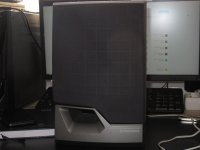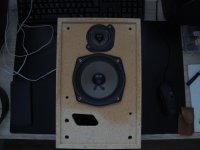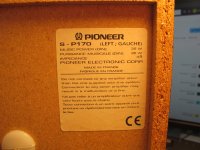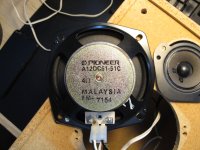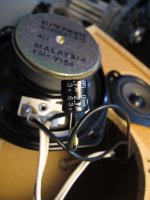Hello everyone,
I have a pair of older Pioneer bookshelf speakers. They were probably never that great sounding, but I think they sound a little dull at the moment. They do not have a crossover, just a single electrolytic in series in between the driver and the tweeter. Can you please recommend a capacitor that is at max 10$ for one, that would bring a new life to them? I have heard a lot of praise for the film capacitors, would they be a good choice? Should the value remain the same (2.7uF)?
Thank you
I have a pair of older Pioneer bookshelf speakers. They were probably never that great sounding, but I think they sound a little dull at the moment. They do not have a crossover, just a single electrolytic in series in between the driver and the tweeter. Can you please recommend a capacitor that is at max 10$ for one, that would bring a new life to them? I have heard a lot of praise for the film capacitors, would they be a good choice? Should the value remain the same (2.7uF)?
Thank you
Attachments
Standard procedure would be to first check that drive units (separately) are working, without the cap (x/o parts).
Then you can do the same with that high pass capacitor by measuring its value.
Should it not measure well, then you can get a spare one for a buck or two.
Then you can do the same with that high pass capacitor by measuring its value.
Should it not measure well, then you can get a spare one for a buck or two.
The value is written on the capacitor, its 2.7 micro farad. If you want to replace it with film capacitor, use 2.7uf polypropylene film.
Do you think it is worth it to go with Wima capacitors or would the little bit cheaper Kemet deliver the same result?
I don't believe in snake oil. Polypropylene is polypropylene, no matter from which brand. But it must be of good quality type. Panasonic is a good option.
One thing i forgot to mention, if you don't find 2.7uf, you can parallel multiple capacitor. Like 0.68uf×4 polypropylene film in parallel configuration. Just try to get 5% or less tolerance type to get the exact value, electrolytic capacitors are not good in this regard which has huge tolerance in value. Anyways, to parallel multiple cap you can use a small perf board if you want to.
Good luck
Good luck
If you increase the value of the capacitor, it will make the tweeter play lower in frequency meaning more "treble" output. This may increase fatigue though as it will likely increase in the sensitive 2 - 5KHz region. If you want more top end (>8KHz) "sparkle / shimmer" e.g. cymbal harmonics then the cap increase won't improve that aspect.
Mundorf MKP. Smooth, dark. Take about 12 hours of playtime to break in. Use Axon for big caps in woofers. Not a fan of Solen but the Axon brand does well in the bass
Last edited:
I think they sound a little dull at the moment.
A common cause of dullness as reported by many newcomers to this forum is that the tweeters are not actually working, having been overloaded by playing the system too loud.
Follow Lojzek's advice to first check that the tweeters are working and that it is not just the mid/bass driver you are hearing.
Regarding the capacitor replacement, the value of 2.7 uF is not critical in this simple arrangement. A commonly available 2.2 uF polypropylene capacitor would do the job without risking damage to a working tweeter.
Lojzek's suggestion is the right path to diagnosis the problem.
Even if the capacitor is old and doesn't have the value it should have, it's unlikely it's the culprit. Galu already mentioned it, the tweeters are most likely done. The tweeters aren't available anymore like all cheap speakers drivers 20+ years old. If you want to restore the speakers, I'd suggest to replace the tweeters with Visaton FR 58 4 Ohm. They go much further up than the original tweeters (~17k), are quite linear, can be xo'd extremely low and will play nicely with just a capacitor. And they aren't expensive.
That's a good suggestion but the capacitor will not participate in any bass reproduction and the speaker is very cheap, so going for Mundorf etc seems to be way overkill.
Even if the capacitor is old and doesn't have the value it should have, it's unlikely it's the culprit. Galu already mentioned it, the tweeters are most likely done. The tweeters aren't available anymore like all cheap speakers drivers 20+ years old. If you want to restore the speakers, I'd suggest to replace the tweeters with Visaton FR 58 4 Ohm. They go much further up than the original tweeters (~17k), are quite linear, can be xo'd extremely low and will play nicely with just a capacitor. And they aren't expensive.
Mundorf MKP. Smooth, dark. Take about 12 hours of playtime to break in. Use Axon for big caps in woofers. Not a fan of Solen but the Axon brand does well in the bass
That's a good suggestion but the capacitor will not participate in any bass reproduction and the speaker is very cheap, so going for Mundorf etc seems to be way overkill.
BS. What's going on with capacitors physically when they »break in«?Mundorf MKP. Smooth, dark. Take about 12 hours of playtime to break in. Use Axon for big caps in woofers. Not a fan of Solen but the Axon brand does well in the bass
Best regards!
I have a pair of Oz made 'Interdyn Pee Wee' monitor speakers with a Fostex 4" and SEAS 0.75" tweeter; they sounded nice but I looked at the 'carefully selected' crossover and found incredibly cheap and nasty parts - a small cap and resistor which looked liked something out of a 1960s transistor radio! The Fostex runs full range.
For about A$8 I replaced the parts with Dayton DMPC poly caps and Dayton resistors and it improved the clarity of the treble; audible, but not 'wow'.
Geoff
For about A$8 I replaced the parts with Dayton DMPC poly caps and Dayton resistors and it improved the clarity of the treble; audible, but not 'wow'.
Geoff
That's a crossover.They do not have a crossover, just a single electrolytic in series
I looked online, is measuring the driver and the tweeter with an ohm-meter enough to determine whether they are working? I have an o-scope but I do not have an audio frequency generator at the time if it is needed.Standard procedure would be to first check that drive units (separately) are working, without the cap (x/o parts).
Then you can do the same with that high pass capacitor by measuring its value.
Should it not measure well, then you can get a spare one for a buck or two.
Oh, okay, I always thought that only pcbs with multiple components are called crossovers. Thank you for pointing that out.That's a crossover.
I looked online, is measuring the driver and the tweeter with an ohm-meter enough to determine whether they are working?
It will tell you whether voice coil has its dcr as it should. You can play music or white noise/mls signal to each driver for testing purposes.
You can add more components as you learn more.I always thought that only pcbs with multiple components are called crossovers.
I used to used an oscilloscope to take impedance measurements, but these days it's often done on a computer. Your skills will help there.
Being able to measure with a microphone is helpful. Also for you to find a way to equalise.
Perhaps the easiest way to check the tweeter for output is to run an app like Spectroid (android) on your phone or tablet with the device's mic against the tweeter while music is playing. Moving the mic close to and then away will reveal what kind of output the tweeter has in the 2k-5k region.
Alright I have disconnected both the driver and the tweeter and measured the dcr. The values seem to be ok, now I continue to playing sound through each of them.
Can I connect just the tweeter to the speaker output of the original HiFi system set it to low volume and play a tone through aux? It won't destroy the tweeter that way, right?
I am also going to rewire these speakers, right now there is a white and gray cable but they are almost indistinguishable, that much worse in bad lighting. The gauge right now is 22AWG, they are rated for 35W so I was thinking 14-16AWG speaker wire, or is it unreasonably thick?
Last thing, they use spade connectors, I do not know how secure they are after time. Can I just solder the wires directly? I do not mind having to solder and de-solder.
Can I connect just the tweeter to the speaker output of the original HiFi system set it to low volume and play a tone through aux? It won't destroy the tweeter that way, right?
I am also going to rewire these speakers, right now there is a white and gray cable but they are almost indistinguishable, that much worse in bad lighting. The gauge right now is 22AWG, they are rated for 35W so I was thinking 14-16AWG speaker wire, or is it unreasonably thick?
Last thing, they use spade connectors, I do not know how secure they are after time. Can I just solder the wires directly? I do not mind having to solder and de-solder.
Attachments
- Home
- Loudspeakers
- Multi-Way
- Capacitor Recommendation For Recapping Cheap Bookshelf Speakers
